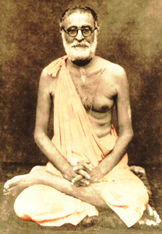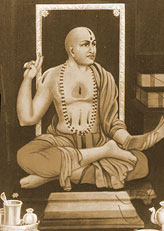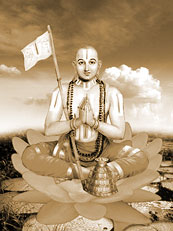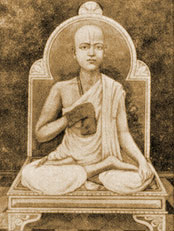
|

|

|

|
|
Bhaktisiddhanta Sarasvati |
Madhvacarya | Ramanuja Acarya | Visnu Svami |
According to Sanskrit etymology, the word 'sannyasa' means 'renunciation' or 'abandonment.' It is a tripartite compound of san (collective), ni (down) and asa (from the root as, meaning 'to throw' or 'to put'). So a literal translation of the word would be 'laying it all down'.
kamyanam karmanam nyasam
sannyasam kavayo viduh
sarva-karma-phala-tyagam
prahus tyagam vicaksanah
"The giving up of activities that are based on material desire is that great learned men call the renounced order of life (sannyasa). And giving up the results of all activities is what the wise call renunciation (tyaga)." (Bhagavad-gita 18.2)
Here renunciation means giving up one's material attachments and possessions for one's own purification of heart and spiritual advancement. Sannyasa is not just a feeling or merely changing of the robes, but in its highest sense, this term indicates, renouncing the apparent sense of identification (samyak-nyasa) with one's self. Another term for a sannyasi is one who is the perfect trustee (samyak-nyasi) of the Lord's belongings i.e, a renunciate who has totally given up self-identification of the material world. Such a sannyasi is a prati-nidhi (representative of the Lord) and not a nidhi-pati (the owner of wealth).
Real renunciation means to engage everything in the service of the Lord and to fix one's aspiration to serve Him with great determination -- not just simply renouncing for the sake of renouncing. If one does so, he is not actually a sannyasi.
anasritah karma-phalam
karyam karma karoti yah
sa sannyasi ca yogi ca
na niragnir na cakriyah
"One who is unattached to the fruits of his work and who works as he is obligated is in the renounced order of life, and he is the true yogi, not he who lights no fire and performs no work." (Bhagavad-gita 6.1)
This basic understanding of sannyasa is found in all the sampradayas, but here we should clarify what separates the Gaudiya Vaisnava sannyasa tradition from other sampradayas.
ONLY A BRAHMANA CAN TAKE SANNYASA
The necessary qualification for taking sannyasa according to Vedic tradition is that one has to be a brahmana, Even if one is not born in a brahmana family, but possesses the qualities of brahmana, then he is a brahmana in the highest sense. Any person, whether he is a brahmana, ksatriya, vaisya, sudra or less by birth, can take to the sannyasa-asrama and attain the proper qualification through the practice of devotional service.
jata-karmadibhir-yastu samkaraih samskrtah sucih
vedadhyayana-sampannah sad sat karmasvasthitah
saucacarasthitah samyag vighasasi guru-priyah
nityabrali satyaparah sa vai brahmana ucyate
"On whose birth and subsequent works have all been purified by the appropriate samskaras, who has the qualities of purity and cleanliness, who is devoted to Vedic study, who performs worship of the Supreme Lord Visnu, and who instructs others in that worship, who is a paragon of the six activities of a brahmana, whose behaviour is never impure, who eats the remnants of his guru's prasada, who is dear to the guru, who always carefully follows his vows, and who is fixed in the truth is known as a brahmana." (Bharadvaja Muni)
While all sampradayas accept that only a brahmana has the qualification to take sannyasa, it is only the Gaudiya Vaisnavas that accept a person as a brahmana on the basis of his qualities and not simply his birth. In this way we can say that the Gaudiyas are much more conservative by following the law of the sastras, than the other sampradayas, that stress janma and not guna.
DIFFERENT TYPES OF SANNYASA
In sannyasa, there are four stages: kuticaka, bahudaka, hamsa and paramahamsa.
According to the Vedic system, when one accepts the renounced order, he stays outside his village in a cottage and his necessities -- especially his food, are supplied from home. This is called the kuticaka stage. When a sannyasi advances further, he no longer accepts anything from home. Instead, he collects his necessities, especially his food, from many places. This system is called madhukari, which literally means 'the profession of the bumblebees.' As bumblebees collect honey from many flowers, a little from each, so a sannyasi should beg from door to door but not accept very much food from any particular house; he should collect a little bit from every house. This is called the bahudaka stage. When a sannyasi is still more experienced, he travels all over the world to preach the glories of Lord Vasudeva. He is then known as hamsa. The sannyasi reaches the paramahamsa stage when he finishes his preaching work and sits down in one place, strictly for the sake of advancing in spiritual life. An actual paramahamsa is one who completely controls his senses and engages in the unalloyed service of the Lord.
Sannyasis can be further divided into two sections -- Brahma-sannyasis and Visnu-sannyasis. Brahma-sannyasis take up the Mayavada philosophy, accepting one among ten different sannyasa names (dasa-nami) -- Tirtha, Asrama, Vana, Aranya, Giri, Parvata, Sagara, Sarasvati, Bharati and Puri. However, Visnu-sannyasis are those who follow the path of devotional service to Visnu or Krsna.
The Mayavadi sannyasi from the Advaita school of philosophy considers himself as God and his concept of life develops under such an illusion. When a person fails to become the Lord of the universe it is like the sly fox that attempts to taste grapes and failing to do so says, "The grapes are sour!" The Mayavadi sannyasis are frustrated in their attempt to enjoy the world, therefore they say the world is false, or 'the grapes are sour'. They don't understand that Krsna is the Supreme Truth and that the world is His energy -- the material energy of the Supreme Truth cannot be false, but we must know that this energy is inferior to His spiritual energy.
sannyasi haiya niravadhi 'narayana'
baliveka prema bhakti yoge anuksana
na bujhiya sankaracaryera abhipraya
bhakti chadi matha mudhaiya duhkha paya
"Sannyasis always say the Name of Narayana and worship Him in prema-bhakti-yoga, Not understanding the position of Narayana, the followers of Sankaracarya give up the path of bhakti -- such fools attain only trouble and misery". (Cb. Antya 3.54-55)
The Gaudiya Vaisnava philosophy instructs one to become a vidvat-sannyasi. This means one knows things as they are. A devotee knows that everything belongs to Krsna and that He is the proprietor of all. Such a devotee is certainly a vidvat-sannyasi. Gaudiya Vaisnava philosophy is that one should accept things as the mercy of Krsna and nothing for one's own sense enjoyment.
Regarding performing duties as a sannyasi, Mayavadis think that a true sannyasi has no duties and has no obligations to fulfill. He does not have to think about the wellbeing of another. His supreme and only dharma is to be ever immersed in atma-vicara -- self-absorption and trying to become one with Brahman. If he does not do so, he is not a sannyasi. Some Mayavadi sannyasis have become so degraded that there is a section of them who eat everything just like hogs and dogs. Such a degraded form of sannyasa is certainly prohibited in this age of Kali. Actually, Sankaracarya's principles for the acceptance of sannyasa were very strict, but later the so-called sannyasis of his school became degraded because their false philosophy propounds that by accepting sannyasa one becomes Narayana.
The Gaudiya Vaisnava sannyasi engages himself fully in the service of Godhead by spreading His message and thus gives some benefit to the public. This type of sannyasa, compared to the Mayavadi sannyasa is categorically different. The Gaudiya sannyasi is not adopting an attitude or tactic of leaving all of the engagements of this world as a result of becoming disgusted with its many temptations. Rather, he is engaging himself in the higher duty of the upper world through an agent, so his body has got utility. Maintaining a connection here, he is drawing some higher principle from above and distributing that in the environment. That is another conception of sannyasa, and it has positive value.
TRIDANDI-SANNYASA AND EKADANDI-SANNYASA
vagdando'tha mano-dandah
kaya dandas tathaiva ca
yasyaite nihita buddhau
tridanditi sa ucyate
"One who accepts in his mind the rod of chastisement for his speech, body and mind is known as a tridandi -- one who has accepted the threefold rod of chastisement."(Manu-samhita 12.10)
Presently tridandi-sannyasa is only found in the Gaudiya sampradaya and Sri sampradaya. A sannyasi's tridanda represents kaya, mana and vakya or body, mind and words. This means that a sannyasi must dedicate these three things to the service of the Lord. In addition, according to the exact regulative principles, it is said that Visnu-svami of the Rudra sampradaya added the jiva-danda to the tridanda making it four dandas, bound together as one. This is symbolic of unalloyed devotional service to the Lord.
Alternatively, Mayavadi sannyasis carry the ekadanda. They are unable to understand the purport of tridandi-sannyasa and as such they are not inclined to dedicate their lives to the service of Mukunda. They simply think of merging into the existence of Brahman because of their frustration with the material world. However ekadanda-sannyasa does not have any sastrika background, whereas tridandi-sannyasa is mentioned in various sastras such as Manu-samhita, Harita-samhita, Jabalopanisad and Srimad Bhagavatam.
SANNYASIS OF THE SRI AND MADHVA SAMPRADAYA
The sannyasa samskaras of the Sri sampradaya are very similar to the Gaudiya Vaisnava tradition. In the Ramanuja sampradaya, first the place is prepared and the candidate is shaved and dressed. Visnu-homa is performed, the previous acaryas are worshipped and the five Vaisnava samskaras (panca-samskara) are enacted on the canditate. Having been given the particular mantras of the sampradaya, the person then performs worship of the guru-parampara and salagrama, Then the sannyasa candidate is given the dress and mantra of the sannyasa-asrama.
In the Gaudiya sampradaya the system is similar. After purifying the place, Visnu-homa and worship of the acaryas of the sampradaya is performed using five articles of worship. Then the qualified candidate may be given sannyasa-diksa. Alternatively one may simply establish asanas and worship the acaryas and Sri Caitanya Mahaprabhu and His associates and then accept sannyasa-diksa.
In the Sri Vaisnava sampradaya it is mandatory that a person go through the stages of brahmacari, grhastha and vanaprastha before accepting sannyasa. In this case there is not much scope for a Sri Vaisnava to preach full time because when they finally accept sannyasa they will have spent most of their life in the other asramas. Therefore in their late stage of sannyasa all they can do is some intense sadhana to achieve Vaikuntha liberation. That is why today there are not that many active Sri Vaisnava sannyasis with the exception of some jiyars from Andhra Pradesh. However, nobody has heard of them outside their own community, proving that their preaching is very limited.
As far as the Madhva sannyasis are concerned, they are probably the most reserved and conservative of all the sampradayas. The rituals that the Madhva sannyasis follow are so complex and time-consuming that their preaching is minimal and lacks dynamism. Most of their time is spent in elaborate Deity worship. They don't see the necessity to reach out to the common people who are affected by the modes of passion and ignorance and who are in the most need. Rather, they give more prominence to the welfare of their own Madhva brahmana community. By becoming gurus and role models for their own small society, their sampradaya has now become totally communal and has no capacity for world preaching.
THE INTERNAL SIGNIFICANCE OF GAUDIYA VAISNAVA SANNYASA
Our Gurudeva, Srila Bhakti Gaurava Narasingha Maharaja has written the following about Gaudiya Vaisnava tridandi-sannyasa:
"From the time of the Six Gosvamis until now, the sannyasa-mantra given to the tridandi-sannyasis has been different than the mantra received by Mahaprabhu. The mantra given at present was first given by Sanatana Gosvami. However, until the time of Srila Bhaktisiddhanta Sarasvati Thakura, the tridandi-sannyasa of the Gaudiya Vaisnava line was not visible. In 1918 Srila Bhaktisiddhanta Sarasvati Thakura took sannyasa from a photo of Srila Gaura-kisora Dasa Babaji Maharaja. Srila Bhaktisiddhanta is known as a self-made sannyasi, a self-manifest sannyasi. It was Srila Bhaktisiddhanta who organized the present standard of the Gaudiya Vaisnava sannyasi -- the dress, the danda, etc. Everything was done by him. The mantra which he gave was the same as the one given by the babaji class, such as Gaura-kisora Dasa Babaji Maharaja and Jagannatha Dasa Babaji Maharaja. This same mantra is presently being given to all the sannyasis in the Gaudiya Vaisnava line." (The Meaning of the Sannyasa Asrama)
When a Gaudiya Vaisnava accepts the external signs of sannyasa, one should understand that his first and foremost goal is to preach Krsna Consciousness and to take the lead as a commander for preaching to the general populace about the urgent necessity of accepting the Supreme Lord and Holy Name. Indeed, preaching Krsna Consciousness is the best welfare activity. It is described by Sri Caitanya Mahaprabhu as para-upakara -- work for the true benefit of others.
Sri Caitanya Mahaprabhu Himself was so merciful and magnanimous in distributing love of God to us almost for nothing. He set an example to this world as a perfect sannyasi who totally renounced this world, possessing the highest mood of bhakti.
anarpita-carim cirat karunayavatirnah kalau
samarpayitum unnatojjvala-rasam sva-bhakti-sriyam
harih purata-sundara-dyuti --kadamba-sandipitah
sada hrdaya-kandare sphuratu vah saci-nandanah
"May that Lord, who is known as the son of Srimati Saci-devi, be transcendentally situated in the innermost chambers of your heart. Resplendent with the radiance of molten gold, He has appeared in the age of Kali by His causeless mercy to bestow what no other incarnations ever offered before -- the most sublime and radiant spiritual knowledge of the mellow taste of His service." (Cc. Adi 1.4)
The Vilapa-kusamanjali expresses the highest summit of devotion -- a sublime, sweet and reassuring hope. In this verse we find the inner ideal of sannyasa and the purport of the sannyasa-mantra.
asa-bharair amrta-sindhu-mayaih kathancit
kalo mayatigamitah kila sampratam hi
tvam cet krpam mayi vidhasyasi naiva kim me
pranair vrajena ca varoru bakarinapi
(Vilapa-kusumanjali 104)
Raghunatha Dasa Gosvami's devotion is so exclusive to Srimati Radharani that he is saying that without Her service he doesn't even care for Krsna. "It is shameless for me to say this, but I don't even want Vrndavana, I don't want Krsna. Your mercy is everything to me." This is the high aspiration of Raghunatha Dasa.
When Sri Caitanya Mahaprabhu received the sannyasa-mantra from Kesava Bharati, he first whispered the mantra to him. He said, "Is this the mantra that you will give me? I have heard it in a dream, 'tat tvam asi.'" The common understanding of this mantra is "You are that!" (you are Brahman). Murari Gupta revealed to Sri Caitanya Mahaprabhu another, more acceptable meaning of this mantra, which Caitanya Mahaprabhu in turn gave to Kesava Bharati: "You are His!" It is considered that at that time Sri Caitanya initiated his sannyasa-guru into the Vaisnava conception of this mantra and then received the mantra back.
For Caitanya Mahaprabhu, it is proper to say that, "I am His -- I am Krsna's." The meaning of the mantra that sannyasis coming from Sanatana Gosvami receive, however, is "I am Hers -- I am Srimati Radharani's. I exclusively engage myself in the service of Srimati Radharani." Actually, She is the highest devotee -- She is the only one who can please Krsna. All bhakti goes through Srimati Radharani. She is tadiya, most dear to Krsna. In that way we should see everything.
Gaura-lila is non-different than krsna-lila. But gaura-lila can be said to be higher, in that it is more magnanimous; it is being distributed (audarya). Mahaprabhu is giving out this ecstatic ocean of krsna-prema. He is experiencing at every moment the great ecstasy of the love of Radha and Krsna, prema pumartho mahan. This is the highest level of devotion.
And it is said, ramya kacid upasana vraja-vadhu-vargena -- the worship shown by the gopis of Vrndavana is the highest, because they gave up everything, renounced everything. They didn't care for their families; they didn't care for their personal happiness at all. They simply were interested in pleasing Krsna. When they met Krsna in Kuruksetra after so long, they were very happy to see him. They pleaded, "Actually, we are only simple village girls with cows as our wealth; we have no qualification; we only know family life; we have not done any austerities; we don't know the Vedas; we are not anyone special. We are not yogis who will be satisfied simply to meditate upon You, but we would like to live with You as Your family." In that way they are humbly approaching Krsna. Krsna considered how fortunate He was to have the gopis' wonderful affection.
In the same way, Caitanya Mahaprabhu has said,
na prema-gandho 'sti darapi me harau
krandami saubhagya-bharam prakasitum
vamsi-vilasy-anana-lokanam vina
bibharmi yat prana-patangakan vrtha
"My dear friends, I have not the slightest tinge of love of Godhead within My heart. When you see Me crying in separation, I am only making a false show of devotion. The proof that I have no love for Krsna is the fact that while not seeing His beautiful face as He plays His flute, I continue to maintain My insect-like existence." (Cc. Madhya 2.45)
The gopis are exemplifying this same extreme mood of devotion. This is saranagati -- surrender. In a higher sense, another term could be used, atmaniksepa. This means to throw oneself desperately toward the lotus feet of the Lord, "I am Yours to be used in Your service as you like, as you see fit."
aslisya va pada-ratam pinastu mam
adarsanan marma-hatam karotu va
"If you like you may embrace me or if you like you may trample me, but use me as you like."
This is the symptom of the surrendered souls that they are ready to be used by the Lord in any way. Srila Prabhupada wrote in his arrival prayer, 'naco gao' -- "As You wish me to dance, I shall dance. And if You don't wish me to dance, I won't dance. It is Your choice, my Lord. I am Yours to be used in Your service." The renounced order, both its external and internal significance, was thus epitomized in Srila Prabhupada. He preached widely and internally fully embraced the service of Srimati Radharani. He renounced the world and became the servitor of Srila Bhaktisiddhanta Sarasvati Prabhupada who organized the present established order of Gaudiya Vaisnava tridandi-sannyasa.
To him we offer our eternal love and gratitude with utmost sincerity.
All glories to Sri Guru and Gauranga.